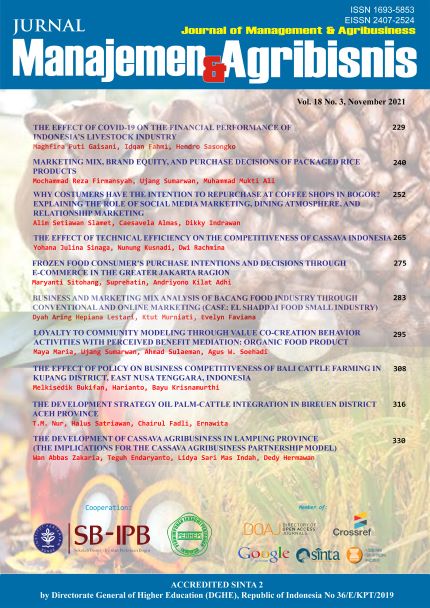Business and Marketing Mix Analysis of Bacang Food Industry Through Conventional and Online Marketing (Case: El Shaddai Food Small Industry)
Abstract
Bacang agroindustry is undeveloped in Indonesia and the internet has not been maximally utilized by bacang entrepreneurs. Therefore, business and marketing analysis of bacang agroindustry is important to do to develop the business and internet utilization for bacang agroindustry. The research aims to analyze profit, cost of goods manufactured, financial performance, marketing mix, and the impact of online marketing on the chicken bacang agroindustry. This research uses a case study method at El Shaddai Food Agroindustry, Penjaringan District, North Jakarta. Research data were collected from December 2019 until February 2020 and the data analysis methods used were qualitative and quantitative descriptive analysis. The results showed that conventional marketing profit was smaller than online marketing profit and the selling price exceeded the cost of goods manufactured, so the agroindustry was considered viable on every marketing method. Financial performance in the last three years was quite good. The marketing mix was not good. Online marketing gave an impact on agroindustry revenue and profit.
Keywords: agroindustry, bacang, business, marketing mix, online
Authors
Authors who publish with this journal agree to the following terms:
- Authors retain copyright and grant the journal right of first publication with the work simultaneously licensed under a Creative Commons Attribution License that allows others to share the work with an acknowledgement of the work's authorship and initial publication in this journal.
- Authors are able to enter into separate, additional contractual arrangements for the non-exclusive distribution of the journal's published version of the work (e.g., post it to an institutional repository or publish it in a book), with an acknowledgement of its initial publication in this journal.
- Authors are permitted and encouraged to post their work online (e.g., in institutional repositories or on their website) prior to and during the submission process, as it can lead to productive exchanges, as well as earlier and greater citation of published work (See The Effect of Open Access).

